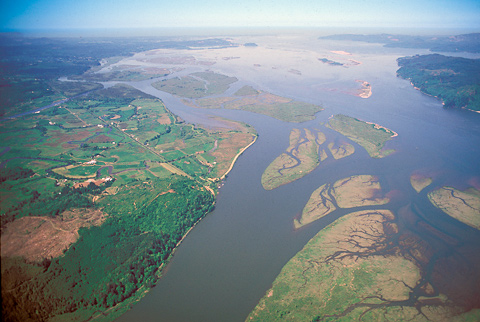The day begins at the mouth of the John Day River where Ordway takes fourteen men to retrieve yesterday’s killed elk. On their way to present Aldrich Point, they cross shallow waters crowded with islands, and a Kathlamet man guides them to the correct channel. The guide claims he is the owner of one of their Indian canoes.
Giving Away the Fort
by Yellowstone Public Radio[1]Originally aired weekdays by Yellowstone Public Radio during the Bicentennial observance of 2003-2006. Narrated by Hal Hansen. Scripts by Whit Hansen and Ed Jacobson. Produced by Leni Holliman. © … Continue reading
Kwakiutl Man, Quatsino Sound (1914)
Edward S. Curtis (1868–1952)
Photo © 2001 Northwestern University Library, Edward S. Curtis’s ‘The North American Indian’: the Photographic Images.
The Kwakiutl Tribe lived between Vancouver Island and the British Columbia mainland. The man above stands in front of a “dog-faced” dugout canoe and wears a robe of woven cedar bark in a manner similar to the Lower Chinook People living along the Columbia River.
Retrieving Elk Meat
This morning we sent out a party of 15, at light, for the meat, and concluded to take breakfast before we set out. they soon returned. we breakfasted and set out at ½ after 9 A. M.
—Meriwether Lewis
Kathlamet Village
at 1 P. M. we arrived at the Cathlahmah [Kathlamet] village where we halted and purchased some wappetoe, a dog for the sick, and a hat for one of the men.
—Meriwether Lewis
Shallow Waters
The tide being out this morning we found some difficulty in passing through the bay below the Cathlahmah village; this side of the river is very shallow to the distance of 4 miles from the shore tho’ there is a channel sufficient for canoes near S. side.
—Meriwether Lewis
Stolen Canoe Discovered
not paying much attention we mistook our rout which an Indian perceiving pursued overtook us and put us in the wright channel. this Cathlahmah claimed the small canoe which we had taken from the Clatsops. however he consented very willingly to take an Elk‘s skin for it which I directed should be given him and he immediately returned.
—Meriwether Lewis
Evening Progress
we continued our rout along the South side of the river and encamped at an old village of 9 houses opposite to the lower Wackkiacum [Wahkiakum] village. the night was cold tho’ wood was abundant after dark two Chinnook [Chinook] men came to us in a small canoe. they remained with us all night. came 15 miles today.
—William Clark
Weather Diary
Aspect of the weather at Rise
Wind at rise
Aspect of weather at 4 O’Ck P. M. Wind at 4 OCk. P. M. rain after clouds & rain S W fair after clouds N W. & S W. at 9 A. M. it became fair and continued fair all day and greater pt. of the night. the brown bryery shrub with a broad pinnate leaf has began to put fourth it’s leaves. [likely salmonberry] the pole-cat Colwort, is in blume. Saw the blue crested fisher. birds are singing this morning. the black Alder is in blume.
—Meriwether Lewis[2]To assist the reader, the editor of this web page has omitted the “Day of the Month” column and spelled out some abbreviations.
Experience the Lewis and Clark Trail
The Lewis and Clark Trail Experience—our sister site at lewisandclark.travel—connects the world to people and places on the Lewis and Clark Trail.
Plan a trip related to March 24, 1806:

Notes
| ↑1 | Originally aired weekdays by Yellowstone Public Radio during the Bicentennial observance of 2003-2006. Narrated by Hal Hansen. Scripts by Whit Hansen and Ed Jacobson. Produced by Leni Holliman. © 2003 by Yellowstone Public Radio. |
|---|---|
| ↑2 | To assist the reader, the editor of this web page has omitted the “Day of the Month” column and spelled out some abbreviations. |


